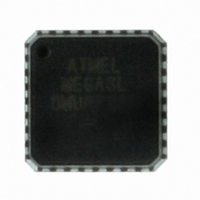ATMEGA8L-8MU Atmel, ATMEGA8L-8MU Datasheet - Page 28

ATMEGA8L-8MU
Manufacturer Part Number
ATMEGA8L-8MU
Description
IC AVR MCU 8K 8MHZ 3V 32-QFN
Manufacturer
Atmel
Series
AVR® ATmegar
Specifications of ATMEGA8L-8MU
Core Processor
AVR
Core Size
8-Bit
Speed
8MHz
Connectivity
I²C, SPI, UART/USART
Peripherals
Brown-out Detect/Reset, POR, PWM, WDT
Number Of I /o
23
Program Memory Size
8KB (4K x 16)
Program Memory Type
FLASH
Eeprom Size
512 x 8
Ram Size
1K x 8
Voltage - Supply (vcc/vdd)
2.7 V ~ 5.5 V
Data Converters
A/D 8x10b
Oscillator Type
Internal
Operating Temperature
-40°C ~ 85°C
Package / Case
32-VQFN Exposed Pad, 32-HVQFN, 32-SQFN, 32-DHVQFN
Package
32MLF EP
Device Core
AVR
Family Name
ATmega
Maximum Speed
8 MHz
Operating Supply Voltage
3.3|5 V
Data Bus Width
8 Bit
Number Of Programmable I/os
23
Interface Type
SPI/TWI/USART
On-chip Adc
8-chx10-bit
Number Of Timers
3
Controller Family/series
AVR MEGA
No. Of I/o's
23
Eeprom Memory Size
512Byte
Ram Memory Size
1KB
Cpu Speed
8MHz
Rohs Compliant
Yes
For Use With
ATSTK600-TQFP32 - STK600 SOCKET/ADAPTER 32-TQFPATSTK600-DIP40 - STK600 SOCKET/ADAPTER 40-PDIP770-1007 - ISP 4PORT ATMEL AVR MCU SPI/JTAGATAVRISP2 - PROGRAMMER AVR IN SYSTEMATSTK500 - PROGRAMMER AVR STARTER KIT
Lead Free Status / RoHS Status
Lead free / RoHS Compliant
Available stocks
Company
Part Number
Manufacturer
Quantity
Price
Part Number:
ATMEGA8L-8MU
Manufacturer:
AT
Quantity:
20 000
- Current page: 28 of 302
- Download datasheet (6Mb)
Low-frequency
Crystal Oscillator
External RC
Oscillator
28
ATmega8(L)
Table 5. Start-up Times for the Crystal Oscillator Clock Selection
Notes:
To use a 32.768kHz watch crystal as the clock source for the device, the Low-frequency Crystal
Oscillator must be selected by setting the CKSEL Fuses to “1001”. The crystal should be con-
nected as shown in
enable internal capacitors on XTAL1 and XTAL2, thereby removing the need for external capac-
itors. The internal capacitors have a nominal value of 36pF.
When this Oscillator is selected, start-up times are determined by the SUT Fuses as shown in
Table
Table 6. Start-up Times for the Low-frequency Crystal Oscillator Clock Selection
Note:
For timing insensitive applications, the external RC configuration shown in
can be used. The frequency is roughly estimated by the equation f = 1/(3RC). C should be at
CKSEL0
SUT1..0
00
01
10
11
0
0
0
0
1
1
1
1
6.
1. These options should only be used when not operating close to the maximum frequency of the
2. These options are intended for use with ceramic resonators and will ensure frequency stability
1. These options should only be used if frequency stability at start-up is not important for the
device, and only if frequency stability at start-up is not important for the application. These
options are not suitable for crystals
at start-up. They can also be used with crystals when not operating close to the maximum fre-
quency of the device, and if frequency stability at start-up is not important for the application
application
SUT1..0
Start-up Time from
Power-down and
00
01
10
11
00
01
10
11
Power-save
1K CK
1K CK
32K CK
Figure 11 on page
from Power-down
and Power-save
(1)
(1)
Start-up Time
258 CK
258 CK
1K CK
1K CK
1K CK
16K CK
16K CK
16K CK
(2)
(2)
(2)
(1)
(1)
Additional Delay
(V
from Reset
CC
4.1ms
65ms
65ms
27. By programming the CKOPT Fuse, the user can
= 5.0V)
Additional Delay
Reserved
(V
from Reset
CC
4.1ms
4.1ms
4.1ms
65ms
65ms
65ms
= 5.0V)
–
–
Recommended Usage
Fast rising power or BOD enabled
Slowly rising power
Stable frequency at start-up
Recommended Usage
Ceramic resonator, fast
rising power
Ceramic resonator, slowly
rising power
Ceramic resonator, BOD
enabled
Ceramic resonator, fast
rising power
Ceramic resonator, slowly
rising power
Crystal Oscillator, BOD
enabled
Crystal Oscillator, fast
rising power
Crystal Oscillator, slowly
rising power
Figure 12 on page 29
2486Z–AVR–02/11
Related parts for ATMEGA8L-8MU
Image
Part Number
Description
Manufacturer
Datasheet
Request
R

Part Number:
Description:
8-bit AVR with 8K Bytes In-System Programmable Flash
Manufacturer:
ATMEL [ATMEL Corporation]
Datasheet:

Part Number:
Description:
IC AVR MCU 8K 8MHZ 3V 28DIP
Manufacturer:
Atmel
Datasheet:

Part Number:
Description:
IC AVR MCU 8K LV 8MHZ COM 32TQFP
Manufacturer:
Atmel
Datasheet:

Part Number:
Description:
IC AVR MCU 8K LV 8MHZ IND 32TQFP
Manufacturer:
Atmel
Datasheet:

Part Number:
Description:
IC AVR MCU 8K LV 8MHZ COM 28-DIP
Manufacturer:
Atmel
Datasheet:

Part Number:
Description:
IC AVR MCU 8K LV 8MHZ IND 28-DIP
Manufacturer:
Atmel
Datasheet:

Part Number:
Description:
IC AVR MCU 8K LV 8MHZ COM 32-QFN
Manufacturer:
Atmel
Datasheet:

Part Number:
Description:
IC AVR MCU 8K LV 8MHZ IND 32-QFN
Manufacturer:
Atmel
Datasheet:

Part Number:
Description:
MCU AVR 8KB FLASH 8MHZ 32TQFP
Manufacturer:
Atmel
Datasheet:

Part Number:
Description:
MCU AVR 8KB FLASH 8MHZ 32QFN
Manufacturer:
Atmel
Datasheet:

Part Number:
Description:
IC MCU AVR 8K 5V 8MHZ 32-TQFP
Manufacturer:
Atmel
Datasheet:

Part Number:
Description:
IC MCU AVR 8K 5V 8MHZ 32-QFN
Manufacturer:
Atmel
Datasheet:

Part Number:
Description:
IC MCU AVR 8K 5V 8MHZ 28-DIP
Manufacturer:
Atmel
Datasheet:












